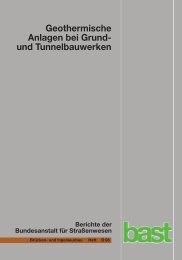Dokument 1.pdf
Dokument 1.pdf
Dokument 1.pdf
You also want an ePaper? Increase the reach of your titles
YUMPU automatically turns print PDFs into web optimized ePapers that Google loves.
Application possibilities of the Accident Causation Analysis System ACAS<br />
using an example of an Extreme Group Comparison of older and younger<br />
drivers<br />
B Pund*, K Duntsch*, M Jänsch**, D Otte**<br />
*TÜV Technische Überwachung Hessen GmbH, Hannover (Germany)<br />
**Accident Research Unit, Medical School Hannover (Germany)<br />
Abstract<br />
From literature well-known analyzes on risks, hazards and causes of accidents of older drivers are amended by the present<br />
study in which a comparison of the specific features of accident causes of older car drivers (older than 60 years) and of<br />
younger car drivers (under 25 years) is conducted. Mainly the question is pursued if specific errors, mistakes and lapses are<br />
predominant in the two different age groups.<br />
The analysis system ACAS (Accident Causation Analysis System) used hereby consists of a sequential system of accident<br />
causation factors from the human, the technical and the infrastructural field, whereupon for this study the influence of the<br />
human features on the accident development in two different age groups is of interest. ACAS is both an accident model and<br />
an analysis and classification system, which describes the human participation factors of an accident and their causes in the<br />
temporal sequence (from the perceptibility to concrete action errors) taking into consideration the logical sequence of<br />
individual basic functions. In five steps (categories) of a logical and temporal sequence the hierarchical system makes human<br />
functions and processes as determinants of accident causes identifiable. The methodology specifically focuses on the use in<br />
so-called "In-Depth” and "On-Scene” investigation studies. With the help of the system for each accident participant one or<br />
more of five hypotheses of human cause factors are formed and then specified by appropriate verification criteria. These<br />
hypotheses in turn are further specified by indicators in such manner that the coding of the causation factors by a code system<br />
meets the needs of database processing and are accessible to a quantitative data analysis.<br />
The first results of the descriptive comparison of the two age groups concern mainly differences in the functional levels<br />
‘information admission/perception’ (where the elderly drivers have more difficulties than the young ones) and ‘information<br />
processing/evaluation’ (where the younger drivers show more problems). Concerning the cognitive function of ‘planning’ the<br />
group of younger drivers seems to be more often involved in an accident because of excessive speed.<br />
Keywords: Accident Causation, In-Depth-investigation method, questionnaires, psychological<br />
investigation, on scene investigation, accidents of younger drivers, accidents of elderly drivers<br />
Introduction and objective<br />
The demographic change in Europe is related with an increasing number of road users in elder<br />
generations. The specific demands and problems of elderly car drivers concern generally<br />
reduced performance skills and especially decreasing driving abilities, which has an influence<br />
on accident causation [1]. On the other side it is well known that many elderly drivers can<br />
compensate their reduced driving abilities to a certain degree. The age group of the driving<br />
beginners too contains specific risks and problems with a remarkable effect on traffic safety<br />
[2]. Therefore, the question of interest is in which way can be differentiated between young<br />
and senior drivers in their contribution to accident causation. The comparison of two extreme<br />
age groups, drivers in the age of 18 to 25 and 60 years and older drivers was carried out to<br />
gain some insight of the specific driving problems of the age groups and to find out about<br />
their impact on car accidents.<br />
A sub-sample of the current German in-Depth Accident Study GIDAS of 64 younger persons<br />
and 44 elder persons involved in a car crash from May 2011 to June 2012 was compared<br />
concerning the given causation codes of the analyzing method ACAS, which was developed<br />
by the Accident Research Unit of the Medical School Hannover in cooperation with the<br />
technical surveillance TÜV Hessen.<br />
01_Duntsch.docx Seite 1 von 6
The structure of ACAS<br />
The Accident Causation Analysis System ACAS include three main elements: an accident<br />
model, a classification scheme and an analysis method, based on the triad ‘the driver – the<br />
vehicle – the traffic environment’.<br />
Accidents are seen as the result of an unsuccessful interplay between those three components,<br />
while 95 % of the accident causes are found in the group of the human influences. The<br />
ACAS-group of human related accident causes consists of five categories related to possible<br />
problems with perceptive and cognitive functions such as observation, interpretation and<br />
planning. The model is influenced by the idea of interactive accident models as an analysis<br />
method of the human information process (cognitions, actions and errors interacting with the<br />
environment; e.g. [3]). Furthermore it refers to dynamic sequence models and emphasizes the<br />
functioning of human processes on their regulation levels and the subsequent errors [4-6]. To<br />
that extent ACAS also has a theoretical proximity to findings of the error analysis (e.g. [7-9]).<br />
Figure 1. ACAS methodology for the analysis of the ‘human factor’ in traffic accidents<br />
The structure of ACAS (figure 1) is oriented at the temporal and structural sequence of the<br />
human functions and processes in the pre-crash phase: initial conditions (e.g. functional<br />
restrictions of the perception ability), perception (attention, registration of the situation),<br />
information processing (diagnosis of the situation, risk assessment), planning (avoidance<br />
planning, action design) and acting (execution, driving maneuver).<br />
By means of the method ACAS it is possible to describe the relevant human causes of<br />
accidents from persons involved in an economic way with a sufficient degree of exactitude,<br />
because the causes can be further differentiated in their values and their sub values. It is<br />
possible that more than one causing moment can be assigned to a person involved in an<br />
01_Duntsch.docx Seite 2 von 6
accident in each of the five functional levels. A data base contains the investigation results<br />
transferred in a coded form.<br />
In the practice of accident investigation at the site of the accident, the sequence chart is also<br />
relevant. With its assistance the questioning of the road users involved in an accident can be<br />
accomplished in a structured way by assigning a set of questions to each category.<br />
For this reason, a special procedure using a semi-standardized questionnaire was developed in<br />
the course of the on-scene accident investigation in Hannover for use with the German in-<br />
Depth-Accident Study (GIDAS). This procedure makes it possible also for a non-psychologist<br />
to compile a substantial amount of information from the persons involved, in order to be able<br />
to better determine the cause of the accidents and to facilitate the coding for data storage at a<br />
later stage. It is possible that causing moments can be assigned to a person involved in an<br />
accident in more than one of the five analyzing levels or to add causing factors from the<br />
causation fields ‘vehicle/technique’ and ‘infrastructure/traffic environment’ so that the<br />
interdependence of different causing factors can be figured out.<br />
Results<br />
Figure 2. Frequencies of accident causes in the ACAS-categories<br />
The frequencies on the five ACAS-categories (figure 2) identify most of the accident<br />
causation factors for both age groups in the category “information admission” where the<br />
elderly drivers have a higher share of perception errors (“look but not see”).<br />
Remarkable differences are found also in the categories “information evaluation” and<br />
“planning”, where the younger age group seems to produce more errors in estimation of<br />
situation and speed. False goal setting in the younger group is concerning deliberate violation<br />
of traffic rules.<br />
01_Duntsch.docx Seite 3 von 6
ACAS – Code<br />
CodeCode<br />
Description<br />
Frequency<br />
12061 Focus on irrelevant road user 9%<br />
14022 Driving above speed limit 9%<br />
12063 Wrong strategy of observation 8%<br />
13031 Underestimation of own speed 6%<br />
13012 Wrong expectation concerning accident place 5%<br />
15025 Overreaction when steering 5%<br />
Figure 3. Most frequent ACAS-codes, age 18-25 years<br />
ACAS – Code Description Description Frequencyu.<br />
12063 Wrong strategy of observation 20%<br />
12061 Focus on irrelevant road user 7%<br />
11024 Sight obstruction by traffic 5%<br />
11044 Dazzled by Light 5%<br />
12028 Distraction from outside the vehicle 5%<br />
12032 Internal distraction (e.g. worries) 5%<br />
Figure 4. Most frequent ACAS-codes, age 60+ years<br />
The frequencies of the detailed causation factors within the categories are shown on figure 3<br />
and figure 4. The most frequent accident causes within the group of 18 to 25 olds (figure 3)<br />
are found on the level of observation errors (codes 12061 and 12063: 17 % together). In the<br />
group of the elderly drivers (figure 4) the same two main causation factors are mostly coded<br />
but in a relatively higher amount of 27 % together. This indicates that perception problems<br />
like failed reorientation or missed reassuring view is related more often to accidents of elderly<br />
car drivers. In addition the older age group shows further perception problems like inattentive<br />
observation by external or internal distraction (codes 12028 and 12032: 10% together). All<br />
codes concerning problems of “information access” and “information admission” sum up to<br />
37 % of causation factors in these perceptual categories which leads to the conclusion that<br />
accident causation due to perception problems is predominant in the group of elderly drivers.<br />
Within the younger age group another main accident causation is related with “speed”.<br />
Driving above speed limit (code 14022: 9%) combined with an underestimation of own speed<br />
01_Duntsch.docx Seite 4 von 6
(code 13031: 6%) describes the typical problems of driving novices: higher risk-taking,<br />
excessive speed and a lack of experience leading to estimation faults regarding the appropriate<br />
choice of speed. Young drivers are also more often subject to expectation errors concerning<br />
the situation at the accident place (code 13012: 5%) and when it comes to a conflict situation<br />
they more often tend to an overreaction when steering (code 15025: 5%).<br />
Summary and Conclusion<br />
A comparative analysis of human related accident causes of driving novices and elderly car<br />
drivers shows especially differences on three of the five causation categories of ACAS. In the<br />
sample “60 years and older” more often perception errors occur: false strategy of observation<br />
and false focus of perception. Though being experienced drivers elderly drivers seem to have<br />
a lack of flexibility concerning the accuracy and speed of perception. In both age-samples the<br />
share of errors in the sub-categories “false strategy of observation” and “false focus of<br />
perception” is nearly the same. Both driving beginners and experienced drivers seem to have<br />
comaparable difficulties with information admission, but with the elderly drivers these errors<br />
rather contribute to a car accident.<br />
In the categories “information evaluation” and “planning” the sample of the younger drivers<br />
however shows more influence on accident causation. A misinterpretation of the situation at<br />
the accident site and an underestimation of own speed are the most frequent influences of<br />
estimation and expectation errors. More often driving novices also tend to a false action<br />
design when planning their driving speed which leads to driving above speed limit.<br />
These first results of a comparison of human influenced accident causation data partly<br />
represent former findings in the age groups of driving novices and elderly drivers. Some<br />
typical age-related influence factors on accident causation could be identified and some<br />
differences could be worked out in a descriptive way. The ongoing data collection within the<br />
German in-Depth-Accident Study (GIDAS) will be able to provide more specific findings<br />
with a increasing number of coded cases. In future the question of significance of these<br />
comparison results should be answered by collecting a sufficient amount of data material.<br />
References<br />
[1] B Moser, I Kurzthaler, M Kopp, E A Deisenhammer, H Hinterhuber, E Weiss, Fahrtauglichkeit im Alter – Welchen<br />
Einfluss hat die Kognition? In: Zeitschrift für Verkehrssicherheit, 1.2012.<br />
[2] B Schlag, D Ellinghaus, J Steinbrecher, Risikobereitschaft junger Fahrer. In: Bundesanstalt für Straßenwesen (Hrsg.),<br />
Unfall- und Sicherheitsforschung Straßenverkehr, Berichte der Bundesanstalt für Straßenwesen, Bergisch-Gladbach,<br />
Heft 58, 1986.<br />
[3] C H Heinrich, K M Porschen, Die Bedeutung interaktiver Unfallmodelle für die Straßenverkehrssicherheitsforschung<br />
In: Zeitschrift für Verkehrssicherheit 35, 1989<br />
[4] D Otte, B Pund, M Jänsch, Unfallursachen-Analyse ACASS für Erhebungen am Unfallort – Seven-Steps-Methode. In:<br />
Zeitschrift für Verkehrssicherheit 3/2009<br />
01_Duntsch.docx Seite 5 von 6
[5] M Jänsch, D Otte, B Pund, U Chiellino, M Hoppe, Implementation of ACASS - Accident Causation Analysis with<br />
Seven Steps – in In-Depth Accident Study GIDAS, Reports on the ESAR-Conference on 5th/6th September 2008 at<br />
Hannover Medical School, Berichte der Bundesanstalt für Straßenwesen, Heft F 72, 2006.<br />
[6] B Pund, D Otte, Assessment of Accident Causation from the Viewpoint on In-Depth Investigation on Scene – Traffic<br />
Psychological Methodology on Examples of In-Depth Cases by GIDAS. In: Reports on the ESAR-Conference on<br />
3 rd /4 th September 2004 at Hannover Medical School, Berichte der Bundesanstalt für Straßenwesen, Heft F 55, 2005.<br />
[7] J Rasmussen, The Concept of Human Error and the Design of Reliable Human-Machine-Systems. In: H P Willumeit &<br />
H Kolrep (Hrsg.), Verlässlichkeit von Mensch-Maschine-Systemen, 255-271, Berlin: Technische Universität Berlin,<br />
1995<br />
[8] J Reason, Menschliches Versagen: Psychologische Risikofaktoren und moderne Technologien. Aus dem<br />
Amerikanischen übersetzt von J. Grabowski. Heidelberg: Spektrum Akademischer Verlag, 1994<br />
[9] H J Küting, Zur Analyse von Denk- und Handlungsfehlern beim Autofahren. In: W R Nickel (Hrsg.) Fahrverhalten und<br />
Verkehrsumwelt, Köln, Verlag TÜV Rheinland, 1990<br />
01_Duntsch.docx Seite 6 von 6
















